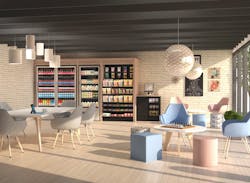Q&A With Fixturelite’s Steve Orlando On Micro Market Design Trends
In order to best serve clients, operators need to stay on top of the latest trends affecting the convenience services industry, including new food and beverage products and broader trends involving consumers’ eating habits. It’s not just about what goes in the micro markets that matters; operators also need to consider the overall look and feel of the market’s physical space. Steve Orlando, co-founder, business strategist and chief business development officer of Fixturelite, encourages operators to create a truly extraordinary experience for their clients.
Q: In your opinion, what is the biggest trend affecting micro markets over the past year?
A: A shift to experiential design. Creating an experience that is unattended retail versus vending on a shelf. The opportunity here is not about taking the products out of the vending machine and putting them on a wire rack. It's about creating an experience for the employee in their break room — or the university student, or whomever it may be — to want to be there, work there and engage more with the products and services that are offered. When that practice results in greater revenue for the micro market operator they begin to see the value. If you don't build it, they won't come, except out of necessity, which is the last thing you want. You want raving fans and customer loyalty.
Additionally, when looking at the recent acquisition trend, operators are looking at exit strategies. When we sold our vending business, we had the latest equipment and technology in place and invested in our locations, making them favorable to a buyer. When you can show exceptional spaces that provide an extraordinary experience that your customers love, that's added value in the grand scheme of things.
Q: What are some of the specific design elements that draw customers into micro markets?
A: A place to gather, relax and collaborate, and [by providing] an exceptional experience in that space. A bar or a booth with a charging station and power, WIFI, internet and cozy lounge furniture. Creating a comfortable environment and a space to break out of the work area and meet with other people, where [employees] go instead of outside of the building in search of those things.
Q: Did the increasing popularity of open offices or shared workspaces encourage this design trend? What other factors are affecting design?
A: I recently discussed this very question with a mentor of ours, Adam Goodman of Goodmans Interior Structures, and he offered the following advice: "Work can be done anywhere, and today’s worker likes to pick and choose where they work depending on the type of task they are working on. Some tasks require isolated, heads-down focus while other tasks are best performed in open, collaborative spaces ... the employer must think about their workspace as competing with the local coffee shop in terms of amenities, comfort and socialization." And I couldn't agree more.
Q: What do you foresee happening in 2020 with this design trend as more millennials enter the workforce, and as Gen Z starts to enter the workforce?
A: As far as 2020 and the years ahead go, with the success that our customers have seen in creating an experience, we've proven over and over again that by investing in the refreshments space and creating an experience for the customer, revenues have gone up. The ROI on the investment is proven in a variety of locations and population groups and sizes. So why wouldn't it continue, and why wouldn't an operator want to obtain more sales by accommodating a variety of customers in the same space as generation mix, all while increasing sales?
Q: How would you advise operators to identify clients who might be a good fit for something extraordinary?
A: I would start by looking at the client who has a market in need of a "refresh" and do something extra there. Then take the client that you think is most suited for an extraordinary experience, and give it your all. Working with (pardon the shameless plug) a company like Fixturelite that has the design tools and the spatial solution experience to provide all the elements necessary for that space without the cost of hiring a professional design firm, which can run in the tens of thousands of dollars. We don't really claim to be a fixture company first and foremost; we're an experience company, and we turn spaces into places that people want to be. The result is increased revenue, longer contracts and longevity at a location.
Your least likely client might do well with this. I've seen where people take a small space with less than 100 people, and they've said, “I'm not going to invest in that because it's only 100 people.” But maybe if they gave it a little extra there, they might see that it brings in more revenue than a 200-person location.
Q: It sounds like a smaller company could bring in as much revenue for an operator as a mid-sized company if they provide the right amenities to encourage their employees to stay in the building.
A: Exactly. It's been proven over and over again. If you go bare-bones basic, you’re probably not going to sell as much and employees probably aren't going to be as happy or engaged with the end result. When you're willing to give it a little more effort — and offer something nicer than the bare minimum — it's a gateway to a conversation with the customer that your competition may not be having. Many times, the employer has money in the budget that the salesperson never talks about or asks for. Quite often, employers are willing to subsidize.
I'm talking about unrealized losses in revenue here, because you never know when a small company is going to grow or get acquired. Give the underdog a chance.






